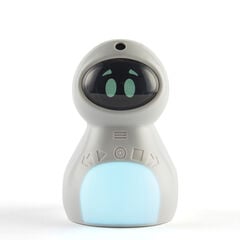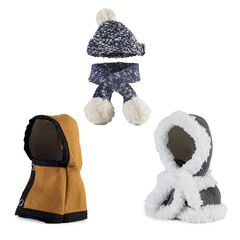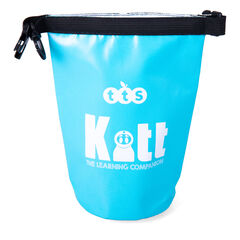What is Kitt?
Kitt is an interactive, non-moving robot, specifically designed to be used by children as a learning companion. It is a versatile tool for use in classrooms, the wider school environment and children’s homes.
Kitt features a built-in camera, video recorder and voice recorder. It is easy to use and is made from a durable material to withstand constant use. Kitt has a smooth exterior and is deliberately tactile. In response to touch and movement, Kitt will vibrate, light up, change tummy colour and make sounds. Additionally, Kitt has a child-like voice, enabling children to relate to it. All these features are both appealing to children and enable them to form a bond with Kitt.
Furthermore, Kitt does not require an internet connection to operate, and is able to store up to 8Gb of multimedia files on its memory card. The files can also be uploaded and saved onto a computer. This allows teachers to evidence children’s work, and share Kitt’s files with the whole class on the interactive whiteboard.
What are the Benefits of Learning with Kitt?
Fosters Independent Learning
Children can easily create videos, take photographs and make voice recordings to support and assess their work, giving them ownership over their learning. Additionally, children can access multimedia files uploaded by their teachers, such as instructions, whenever they need it. This promotes self-sufficiency and helps to build self-esteem and confidence.
Enhances Children’s Focus and Engagement
Kitt’s multi-sensory features and appealing design capture children’s attention. Designed to be used by children, Kitt is an unintimidating bot that children easily engage with. Additionally, Kitt has an engaging timer, which features a colour-changing tummy. Kitt’s tummy changes from green, to amber then red as time passes; eventually turning blue and sounding an alarm when time is up. It also has a clear countdown display and the timer can be set to various durations, helping children stay on task.
Promotes Inclusivity
Teachers can upload files onto Kitt that children can access independently to differentiate and support their learning. Kitt’s features can also be customised to support the needs of individual children. For a comprehensive overview of how Kitt promotes inclusivity, including strategies for supporting children with SEND, read our Kitt Robot – an Inclusive and SEND Classroom Resource blog and Kitt SENCo Guide.
Develops Speaking and Listening Skills
Kitt is an excellent tool for developing communication skills. For ideas on how to use Kitt across the curriculum to enhance speaking and listening skills, read our Speaking and Listening Skills with Kitt guide.
Provides Companionship to Promote Wellbeing
Kitt can offer comfort to children in many ways. Children can interact with Kitt, with it responding with vibrations, a happy face and its tummy colour changing to pink, creating a nurturing interaction. Children can also express their feelings by talking to Kitt and recording their emotions. Furthermore, teachers can upload mindfulness videos or exercises for children to access when needed.
Works as an Offline Device
Kitt is a standalone device so teachers do not have to rely on an internet connection for Kitt to work. This means that Kitt can be used in a variety of settings. Furthermore, it is particularly valuable for children facing digital poverty, as it enables them to engage with education devices at home.
Builds Home and School Connections
Kitt can be sent home with children and used for multiple purposes. Teachers can upload files to support children with homework. Children can use Kitt to record homework tasks or to share home interests, such as a hobby or family tradition. Furthermore, children can use Kitt as a reading buddy at home to listen to stories and to record themselves reading to Kitt. Additionally, children with EAL can use Kitt to practise saying some key phrases or to listen to English at home.
Offers Versatility
Kitt’s range of features and functions means it can be used to support learning in the classroom, at home and in the wider school environment.
Learning with Kitt Across the Curriculum
Below we will explore the many ways tha Kitt can be used in a range of subjects to support children’s learning.

Writing with Kitt

Suggestions for using Kitt’s Voice Recorder to support writing across all subjects:
- Saying Sentences – Children record themselves saying sentences and play them back to help them structure their writing.
- Reading out work – Children record themselves reading out their work and play it back to help them with editing and intonation.
- Recording Ideas – Children who struggle to record their ideas in writing can use the voice recorder instead which the teacher will be able to access and review.
- Retelling Stories and Events – Children can retell a story or event verbally which they can play back later to support them when recording the story or event in writing.
- Answering Questions – Children use the voice recorder to answer given questions about a subject, such as comprehension questions. This is particularly useful for children who are slow to record or have learning difficulties such as dyslexia.
- Recording Processes – Children record a process, such as instructions of how to do something, and then use the recording to help them structure their writing.
- Verbal Word Banks – Children create a verbal word bank of words that they want to use in a piece of writing. This enables children to record all the words they want to use without being hindered by the spelling.
- Recording Lesson Content – Teachers can record instructions to support writing activities, which children can play back as often as they need.

Ideas for using Kitt’s Video Recorder to support writing across all subjects:
- Videoing Drama Activities – Children record drama activities, such as hot seating or acting out a story. They can play them back, as often as they need, to support them with writing activities. Furthermore, some children will find performing to Kitt less intimidating than performing in front of the class, resulting in better performances.
- Videoing School Trips and Events – Children record specific activities during school trips and events. They then use the footage to help them recall when and where different activities took place, to support them when writing about trips and events.
- Videoing Practical Activities – Children record practical activities, such as science experiments and DT projects, and use the footage to help them write explanations and instructions.
- Videoing Instructional Activities – Teachers can record videos that explain writing tasks, including themselves modelling writing, which children can access as often as they need.
- Videoing Feedback – Teachers and peers can record feedback of written work, showing sections of writing that worked well and areas for improvement.
- Self-Assessment – Children can record themselves reading out their work which can help them identify areas for improvement.

Using Kitt’s Camera to support writing across all subjects:
- Photograph Visual Prompts – Children take photographs of objects, scenes and activities to provide inspiration and help them recall events.
- Photograph Drama Activities – Children take photographs of drama activities, such as freeze-framing, and use the photographs to aid writing. This is also time efficient for teachers, as they will not have to photograph each group.
- Storyboarding – Children take photographs of images, including drama activities, to help them sequence a story.
- Feedback – Children take photographs of their work for their peers to review. Work could be blindly peer-assessed so children provide unbiased feedback.
- Record Processes – Children take photographs of different stages of a process, such as a science experiment or DT project, which they can then use to write explanations and instructions.
- Creating Non-Fiction Texts – Children take photographs of objects, scenes and activities to help them structure and create non-fiction texts such as booklets and posters etc.
- Sharing Achievements – Children take photographs of their writing to share with their parents at home.
Reading with Kitt

- Book Talk – Children record, using the voice or video recorder to record their ideas about a book. This is particularly useful for children who are reluctant to talk in front of others.
- Practising Intonation – Children record themselves reading a range of literature, using the voice or video recorder, and play it back to assess how they can improve.
- Listening to Stories – Children listen to a range of stories being read by different adults to hear intonation being modelled. Children can also follow stories by having the physical book with them and turning the pages which can also help them with word reading.
- Performing Poetry – Children use the voice or video recorder to record themselves performing poetry. This is useful for children who struggle performing in front of others and for self-assessing their rhyme and intonation.
- Learning Phonics – Children can use Kitt’s camera to take photographs of words and objects with the same sounds and initial letters. Furthermore, teachers can upload audio files and videos for children to practise saying and reading different sounds and letters.
Further Ideas for Learning with Kitt Across a Range of Subjects

- Maths – Children record explanations of how they’ve worked out problems – especially if working out a challenge.
- Science – Children take photographs and videos of experiments to help them write explanations and conclusions.
- Computing – Children explore how Kitt works to understand more about how robots work.
- Design and Technology – Children take photographs and recordings of processes to help with explanations and to refer to when returning to a project.
- Geography – Children take photographs of physical and human geographical features.
- History – Children make recordings of older relatives talking about the past, including significant events in history.
- Languages – Children listen to recordings made by the teacher in a foreign language and practise saying or writing the words and sentences.
- Music – Children record their own compositions and listen back.
- Art – Children take pictures of their finished artwork and artwork in progress to record in books.
- Physical Education – Children record sequences (dance routines, jumps, throws etc.) to compare and improve.
- PSHE – Teachers record positive phrases that children can listen to, especially those with low self-esteem.
For more ideas on how to use Kitt across a range of subjects, download our Kitt Cross-Curricular Ideas cards.
Dressing-up Kitt
You may wish to dress Kitt up in different outfits for various subjects and activities throughout the day. This fosters a sense of belonging among children and makes Kitt a recognisable member of the school community. The children could also get involved in making clothes for Kitt which will help to build a stronger connection with Kitt. Additionally, for convenience, son ready-made outfits for Kitt are available on our website.
Kitt’s Timer

Kitt’s engaging timer is great for transitions, focussed tasks, and organisational tasks such as tidying up. To find out more about how Kitt’s timer can be used throughout the school day, read our Day in the Life of Kitt download.
For useful strategies for introducing Kitt to your class, read our How to Introduce Kitt to Children blog.
To listen to school practitioners talk about the ways that they have used Kitt in school, including the school SENCo, watch our Terrific Testing Squad: Kitt, The Learning Companion video.
Conclusion
There are so many ways that you can use Kitt the learning companion to enhance learning across the curriculum. Its user-friendly design and inclusive features make it an invaluable resource in the classroom, promoting engagement and independence among children.













